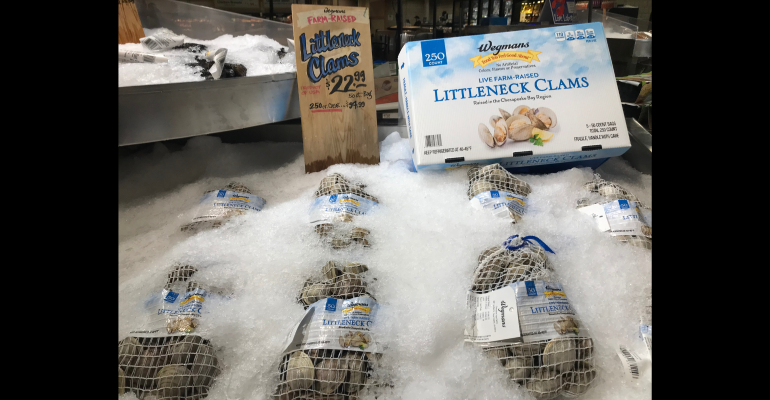Proper sanitizing of the supermarket seafood department is essential if retailers are to enhance food safety and create a perception of cleanliness and quality. But keeping the wide range of potential contaminants in check can be tricky.
While disease causing bacteria may be present at low levels during seafood harvesting, additional pathogens often appear in foods through improper handling, processing, and by unsanitary seafood department conditions, said Robert Gravani, professor emeritus of food science at Cornell University in Ithaca, N.Y.
“Conditions in supermarket seafood departments can impact safety by increasing pathogens and allowing them to grow, which can lead to foodborne illness,” he said. “Correct seafood handling at the store level is critical from a food protection standpoint.”
Issues often arise from inadequate or improper employee training, poor personal hygiene, improper temperature control, inadequate cleaning and sanitizing of equipment, and a lack of attention to detail, Gravani said, adding that such conditions also can contribute to cross-contamination of products.
“Cross-contamination is one of the biggest risks to seafood safety,” said Shipra Pareek, senior account manager, food retail, at NSF, an Ann Arbor, Mich.-based provider of testing, inspection, certification, and advisory services and digital solutions. “Improperly cleaned surfaces, utensils, storage racks, and refrigerators can lead to the spread of pathogens and exposure of allergens.”
Similarly, improper handling of seafood can cause allergen cross-contact, where allergenic proteins from one type of seafood transfer to another, posing a risk to individuals with allergies, she said. Other practices leading to cross-contamination include storing raw products too close to cooked items in store refrigerators and topping seafood ice beds with new ice, Pareek said.
Additional sanitary deficiencies include storing seafood at temperatures that are too high, which can quickly lead to spoilage and bacterial growth; poor hand washing; inadequate cleaning of refrigerators, freezers, utensils, and scoops; and the presence of pests, such as houseflies and rodents, she said.
“Retailers must have a comprehensive allergen management plan to eliminate risks,” Pareek said. “Good hygiene practices also should be employed at all levels of the organization and, because refrigerators and freezers can shut down during power outages, there should be a plan to mitigate that risk to seafood.”
Operators will also benefit by ensuring there is a quick transport of seafood to proper storing conditions, and adapting preventive indicators, such as periodic third-party audits, “to identify the gaps and fix them,” she said.
Perhaps most crucial is attracting and retaining motivated seafood department employees and using innovative methods to train the workers on food safety and sanitary practices, Gravani said. “The success of any food safety program clearly rests on the knowledge and skills of personnel performing the everyday tasks of cleaning and sanitation,” he said.
Company executives and store management can demonstrate strong leadership through the development of an encompassing employee training program that addresses the importance of each employee’s role in assuring seafood safety, Gravani said. That includes understanding the tasks they need to perform along with how, when, and why they need to execute the measures, he said, adding that excellent employee performances should be recognized and rewarded.
“Seafood retailers should prioritize training team members and provide updated resources on a recurring basis by either working with their internal training team or hiring a third party to assist,” Pareek said. “An effective food safety culture involves active participation from all employees. Make sure that employees fully understand the sanitation policies and processes in place by celebrating wins, enforcing regular checks, and hosting ongoing training.”
Operators should deliver follow-up refresher training on a periodic basis to update employees’ food safety and sanitation knowledge and skills, Gravani said. “Key for assuring good quality seafood is the development and maintenance of a well-trained, effective, and reliable workforce who can perform all tasks necessary to prevent foodborne illnesses,” he said. “As new technologies emerge, keeping abreast of the latest developments on cleaners and sanitizers and their use, as well as chemical delivery systems, is vital.”
Personnel also should follow a master sanitation schedule which details the items needing cleaning and sanitizing; cleaning frequency; the specific methods that employees will follow for each task; the individuals responsible for completing each task; and a check of when the job was completed, Gravani said.
Pareek agreed, noting that “it is important for seafood retailers to stay up to date with new and existing regulations and ensure that they are in full compliance. Working with a third-party organization can help as consultants and auditors can confirm that best practices are being followed and that organizational standards are met.”




